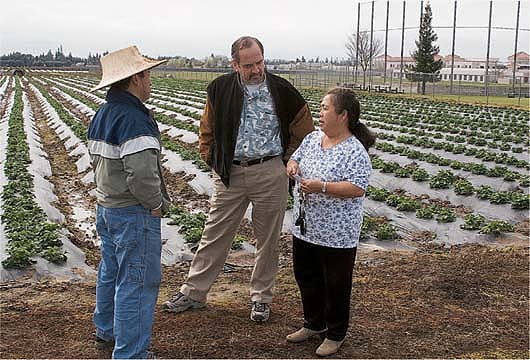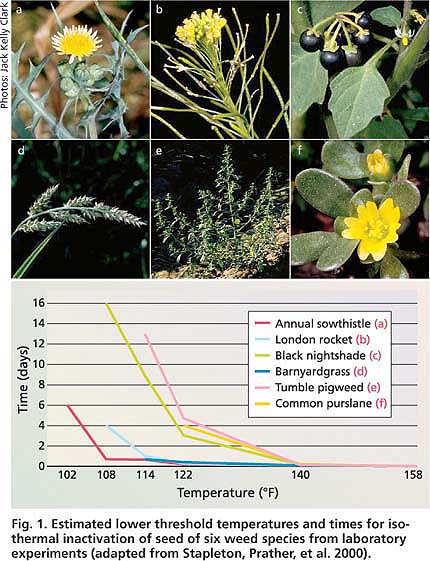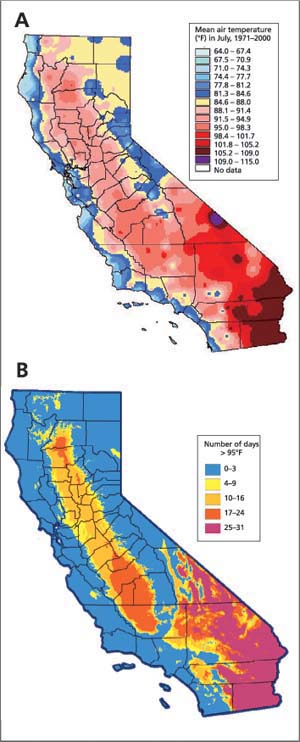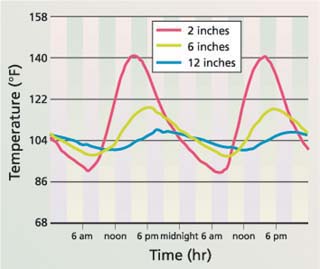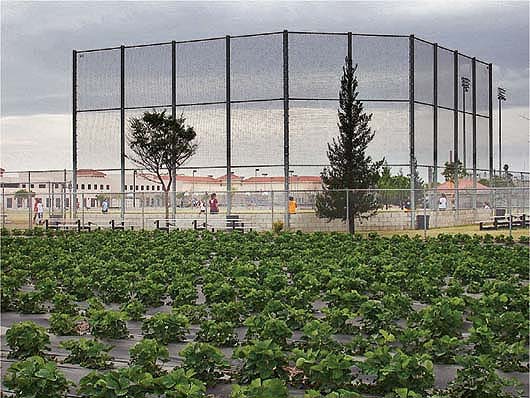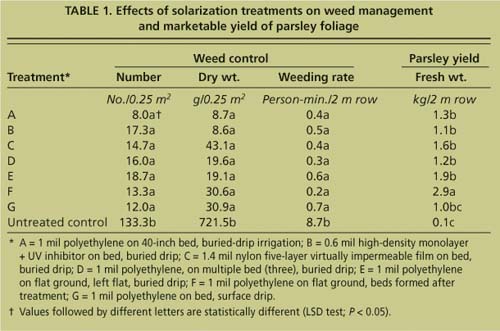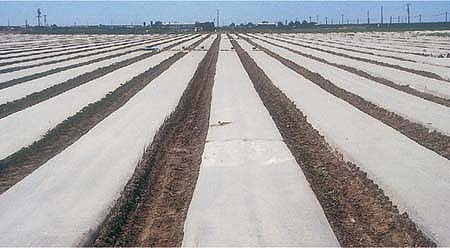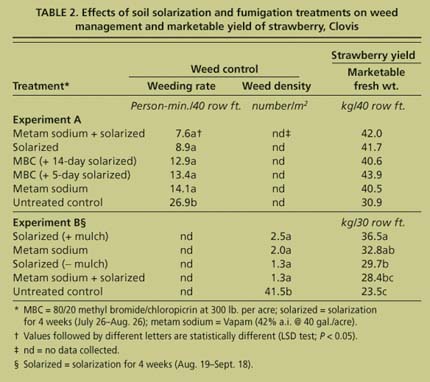All Issues
Methyl bromide alternatives … Soil solarization provides weed control for limited-resource and organic growers in warmer climates
Publication Information
California Agriculture 59(2):84-89. https://doi.org/10.3733/ca.v059n02p84
Published April 01, 2005
PDF | Citation | Permissions
Abstract
Organic farmers and limited-resource growers in the San Joaquin Valley and other agricultural areas in California—many of whom are ethnic minorities—encounter limited options and environmental constraints when seeking economically viable pest management methods. Over the past 8 years, we have conducted weed research and implementation projects on soil solarization at the UC Kearney Research and Extension Center and on farms in the surrounding San Joaquin Valley. In the Kearney studies, small-scale solarization in parsley reduced weed biomass 94% to 99% over the untreated control. Furthermore, in an on-farm study, solarization provided effective weed control for strawberries at a much lower cost than methyl bromide, with comparable yields. This research has provided guidelines and technical support for growers wishing to implement solarization and related techniques for nonchemical soil disinfestation in a wide variety of specialty crops.
Full text
More than 80% of California farms are small family operations, making less than $250,000 in annual gross income, according to the U.S. Department of Agriculture's definition. Of these, 85% gross less than $100,000 annually. Classified as limited-resource farms, these comprise 72% of all California farms. To survive economically, small farms must depend on high-value specialty crops, specialized marketing programs or specific market windows. In many San Joaquin Valley counties, minorities, including Asians, Latinos, blacks, American Indians and others, operate almost 50% of the small farms. Fresno County's farmers are more diverse than those in any other California county, with a large proportion of Asian and Latino farmers. The Asian farmers are primarily Hmong, Lao and other groups that have emigrated to the United States since 1979. Although the total number of small farms in California decreased by 9.5% between 1997 and 2002, the number of minority farm operators increased by 52% (USDA 2004), with the largest proportional increases in Latinos (65%) and American Indians (70%).
Soil solarization is a “perfect fit” for small-scale specialty crop growers like Ong Lee Yang (right), according to Richard Molinar, Fresno County small farms advisor (middle). Central Valley strawberry growers can take advantage of hot summers to tarp their fields in July and August between production cycles. Interpreting for the Hmong farmer is Michael Yang (left), a UC small farms program representative.
Although only about 2.5% of all California small farms are registered organic, statewide farmland in production for the organic market totals more than 175,000 acres (CDFA 2002). Limited-resource growers and organic farmers in the San Joaquin Valley and other agricultural areas confront limited choices and environmental constraints when seeking economically viable pest management options. Many specialty crops have few labeled pesticides, due to the high development and support costs and low returns for the manufacturers. Organic growers are at an additional disadvantage due to the restrictions on pesticides allowable under organic certification programs. Also, many of the farms are located at the urbanagricultural interface, and the use of pesticides and fumigants is further restricted in fields close to occupied buildings. In general, weed management is the most pervasive problem for San Joaquin Valley specialty crop and organic growers.
Strawberries have been an important specialty crop for San Joaquin Valley small farmers, with the majority of the acreage located in Fresno and Merced counties. The Fresno County Agricultural Commissioner reported 137 acres of strawberries worth nearly $1.5 million in 2002, albeit less than 1% of the statewide total. The cultivation of strawberries in the San Joaquin and Sacramento valleys is quite different from that of the major strawberry production areas along the California coast, with a short, split, fall-spring harvest season and most fruit destined for processing and roadside sales, rather than fresh-market shipping. Most San Joaquin Valley strawberry farmers are Hmong immigrants who produce much of the crop at the urban-agricultural interface, often on rented land in close proximity to occupied buildings.
Historically, most strawberry fields in the San Joaquin Valley are fumigated every 2 to 3 years, depending on weed pressure and the availability of funds, while coastal plantings are usually fumigated every year. However, many of the strawberry fields in the San Joaquin Valley are close to shopping centers and residential homes, so growers may find fumigation impractical. Pesticide regulations require that growers maintain buffer zones between fumigation areas and occupied dwellings (Carter et al. 2005).
Also, while most fumigations in the past were done with methyl bromide/chloropicrin, the regulatory phase-out of methyl bromide has increased the cost of the remaining supply to the point of being prohibitive. In 2003, many San Joaquin Valley strawberry fields were fumigated with metam sodium, a moderately effective alternative fumigant that is significantly less expensive than methyl bromide (Richard Molinar, UC Farm Advisor, personal communication).
An alternative to chemical fumigation is soil solarization, a hydrothermal soil-disinfestation process that utilizes clear plastic mulch to trap solar radiation in moist soil. Solarization during the hot summer months can increase soil temperatures to levels that can kill soilborne disease, nematodes and weeds (Elmore et al. 1993). As with methyl bromide, plants often grow faster and produce higher yields when grown in solarized soil, as a result of weed and disease control, the increased solubility of nutrients, and changes in the microbial composition of the soil (Stapleton, Elmore, et al. 2000). Soil solarization can be a safe and effective method for controlling soil pests, and its effectiveness can be improved by combining it with other treatments such as fertilizers, cruciferous crops and other chemical treatments including metam sodium.
In this report, we describe solarization technology for weed management. This project, conducted at the UC Kearney Research and Extension Center (KREC) over the past 8 years, consisted of laboratory development, small-plot experimentation and on-farm validation of data in San Joaquin Valley specialty crops.
Preliminary laboratory studies
As a first step, earlier laboratory work done at KREC from 1997 to 1999 developed threshold treatment dosages for estimating weed management by soil heating (Stapleton, Prather, et al. 2000). In a series of experiments, we subjected the seed of six important weed species — barnyardgrass (Echinochloa crus-galli), London rocket (Sisymbrium irio), common purslane (Portulaca oleracea), black nightshade (Solanum nigrum), annual sowthistle (Sonchus oleraceus) and tumble pigweed (Amaranthus albus) — to timed heat treatments at 102, 108, 114, 122, 140 and 158°F (39, 42, 46, 50, 60 and 70°C). The weed species were selected to represent a range of thermal sensitivities and summer versus winter growing habits. Percentages of viability were determined 14 days after removal from the heat treatments.
Fig. 1. Estimated lower threshold temperatures and times for isothermal inactivation of seed of six weed species from laboratory experiments (adapted from Stapleton, Prather, et al. 2000).
Fig. 2. Air-temperature maps of California in July, showing (A) mean daily maxima (30-year average); and (B) mean number of days in the month with maxima greater than or equal to 95°F (10-year average). Raw data source: National Climatic Center, NOAA.
Fig. 3. Typical diurnal soil-temperature curves during solarization in the San Joaquin Valley, at three depths.
At 158°F (70°C), the seeds of all species were dead within 20 minutes, and at 140°F (60°C) all species were dead within 3 hours. At 122°F (50°C), complete seed destruction occurred between 4 hours (annual sowthistle) and 4.7 days (tumble pigweed). At 114°F (46°C), thermal death occurred at a range of 15 hours (annual sowthistle) to 13 days (tumble pigweed). At 108°F (42°C), barnyardgrass, tumble pigweed and common purslane germinated inside the jars during the heat treatment. Barnyardgrass, tumble pigweed and common purslane were not studied at 102°F (39°C), since 108°F (42°C) had no effect on their viability (fig. 1). Additionally, the portion of this laboratory study conducted at 140°F (60°C) and 158°F (70°C) was used to assist in developing guidelines for the weed disinfestation of container nursery soil using a specialized solarization technique (Stapleton et al. 2002).
One of the challenges facing many small-scale farmers in California is their close proximity to urban areas. This strawberry field is adjacent to a baseball field at Sunnyside High School in Fresno. Solarization affords a safe, non-chemical alternative for dealing with certain pest problems.
Developing guidelines using GIS
Solarization is a knowledge-based, rather than product-based soil disinfestation method. As such, end users are largely without the benefit and availability of the trained consultants and product support personnel associated with chemical pesticides. Many growers, pest control advisors and gardeners are often unsure as to the suitability of solarization for their particular geographic locations. To facilitate decision-making, we collaborated with the Kearney Agricultural Center (KAC) Geographic Information Systems (GIS) unit to create statewide air-temperature maps, using historical temperature databases obtained from the National Oceanic and Atmospheric Administration's National Climatic Data Center. These maps include both monthly air-temperature maxima (fig. 2A), and mean number of days warmer than minimum thresholds (a 95°F [35°C] minimum is depicted in fig. 2B), which can be accessed ( www.uckac.edu/iwgss ) by users who wish to estimate the suitability of their area for solarization.
Within the next few months, soil temperature models will be added to the Web site, to provide additional decision support for users (fig. 3). At the present time, however, users should conduct tests with soil thermometers or other temperature-sensing equipment to assess the potential for using solarization on their own land and for their particular climatic niches.
Small-plot field studies
Several small-plot studies were conducted at KREC to support the weed-seed inactivation studies conducted in the laboratory. In the study described here from the 2003–2004 growing season, variations of solarization techniques (three plastic formulations; single bed, multiple bed and flat ground application; surface versus subsurface drip irrigation) were compared in a randomized complete block design to an untreated control for weed management efficacy and effects on yield of parsley (Petroselinum crispum cv. Italian dark-green plain leaf).
TABLE 1. Effects of solarization treatments on weed management and marketable yield of parsley foliage
Solarization is an effective tool against many shallowly distributed soilborne nematodes and diseases such as Verticillium wilt, as well as most weeds. The $150 to $300 per acre cost for a row application, above, is much cheaper than methyl bromide fumigation.
Beds, where used, were formed and shaped on 40-inch centers in an east-west orientation on the Hanford fine sandy loam soil. Three replications of each of the eight treatments were done, and soil temperatures were continuously monitored in one replication of each treatment. Each replication was three beds wide by 30 feet long. Plastic was laid on July 9, 2003, irrigated via the surface or subsurface drip systems, and removed on Sept. 4. Following plastic removal, parsley was planted on Oct. 2. A 6.6-foot (2-meter) row length of each replication was subjected to timed hand-weeding on Jan. 23, 2004. Additionally, subsamples (2.7 square feet = 0.25 square-meter quadrats) of emergent weeds from each plot were counted and separated by species on Feb. 19. To assess the effects of treatments on the yield of parsley foliage, two cuttings were made on Feb. 12 and March 22.
At the time of the initial evaluation on Jan. 23, 2004, Conyza sp., henbit (Lamium amplexicaule), swinecress (Coronopus didymus), redmaids (Calandrinia ciliata), groundsel(Senecio vulgaris) and annual bluegrass (Poaannua) were the most numerous of the emergent weeds, and redmaids and common chickweed (Stellaria media) comprised the bulk of the weed biomass. Results showed that all of the solarization treatments were equally effective in providing weed management (P < 0.05), with weed numbers reduced by 86% to 94%, and weed biomass reduced by 94% to 99%, as compared with the untreated controls (table 1). Similarly, the timed hand-weeding showed that all of the solarization treatments reduced the labor time necessary to maintain commercial weed control in the plots by 92% to 97%.
This data clearly demonstrated that for specialty and organic crops grown in the San Joaquin Valley where chemical herbicides are not available or allowable, solarization can provide excellent control of winter weeds. In terms of the yield of the parsley foliage, the untreated control was so choked with weed growth that little parsley could be harvested. In a commercial situation, the field would have been abandoned with weed growth this extensive. All of the plots receiving solarization treatments provided an economic yield of parsley foliage, ranging from 6.7-fold to more than 20-fold increases over the untreated control. Yields from each of the solarization treatments were significantly different from the untreated control, except the one testing surface drip rather than subsurface drip irrigation (table 1).
On-farm comparisons near Fresno
To test and compare the herbicidal and strawberry fruit yield effects of solarization and standard soil fumigants under commercial field conditions, two on-farm field experiments were conducted in the Fresno-Clovis area of the San Joaquin Valley from 1997 to 1999. Field histories and pre-experiment soil assays confirmed that weeds were the only major soilborne pest problem of concern. The first experiment (A) was located in the midst of an urbanized area, with residential housing less than 100 feet from the edge of the field, and was in the third year since the previous fumigation using methyl bromide. Plot design was a randomized complete block with three replications. Each replicate consisted of three beds (double-row planted) on 54-inch centers, 130 feet long. Bed orientation was north-south, and soil type was Greenfield coarse sandy loam.
The preplant soil-disinfestation treatments included: (1) methyl bromide/ chloropicrin (applied by a commercial applicator on July 30, 1997, using an 80/20 mixture at 300 pounds per acre plus plastic tarps left on 2 weeks); (2) methyl bromide/chloropicrin as above plus plastic left on only 5 days; (3) solarization with clear plastic for 4 weeks (July 26 to Aug. 26); (4) metam sodium (Vapam, 42% a.i.) at 40 gallons per acre (applied via drip irrigation as a bed treatment; application rate expressed as the broadcast rate injected through drip lines on Aug. 12) plus solarization for 4 weeks; (5) metam sodium plus plastic left on only 48 hours; and (6) the untreated control. Soil moisture was applied by preirrigation. Strawberry (Fragaria x ananassa cv. Chandler) plants were set out on Aug. 28 and drip-irrigated. Plant spacing down the row was 12 inches, and a standard fertilizer and insect management program was followed according to the grower's preferences. Yields were taken from 40-foot lengths of the middle beds only.
TABLE 2. Effects of soil solarization and fumigation treatments on weed management and marketable yield of strawberry, Clovis
In 2002, more than 65 “minor” or specialty vegetable and fruit crops worth more than $75 million were grown on 17,000 acres in Fresno County. Among the producers of those crops is Will Scott, Jr. (left) and his brother Melvin (on tractor), who grow turnips, peanuts, squash and other crops, and truck them to Oakland for sale at a local farmers market. Scott is working with Cooperative Extension in field trials to demonstrate solarization to fellow members of the African American Farmers Organization he helped found.
The second experiment (B) also was located in a residential area, on Ramona sandy loam soil. The site had been fumigated with methyl bromide/chloropicrin one season earlier. Bed spacing was 54 inches from center to center, and treatment plots were 30 feet long. Again, the plot was laid out as a randomized complete block, but with four replications of each treatment. Treatments were the same as in experiment A, except that methyl bromide/chloropicrin fumigation was not included, and single-bed replications were used. Soil in planting beds was solarized for 4 weeks later in the year than in experiment A (Aug. 19 to Sept. 18,1998) using clear, 1-mil (0.025 mm) polyethylene film. Metam sodium (Vapam; 42% a.i.) was applied in the same way as in experiment A. The film was left on the ground and plants transplanted through it after solarization in one of the treatments. Following the soil disinfestation treatments, ‘Chandler’ strawberry plants were set out on Sept. 18 at an in-row spacing of 12 inches, two rows per bed, and the fertilization and insect management practices of the grower were followed. Soil temperatures were monitored in both experiments, and the data collected included weed management parameters and marketable berry yields.
Weeding costs, person hours
Experiment A
All plots in experiment A were hand-weeded on four different dates (Oct. 6 and Nov. 10,1997; Jan. 23 and Feb. 17,1998), based on the weediness of the untreated control, which was moderate at the time of each weeding. The time taken to hand-weed a 40-foot-long strip of each replication was recorded and totaled. All treatments required 48% to 72% (P < 0.01) less time to weed than the untreated control (table 2). None of the costs for solarization and/or chemical fumigant treatment were different from each other. When the hand-weeding labor cost, estimated at $7.90 per hour, was extrapolated to an entire field, use of the soil disinfestation treatments would have saved the grower $127 (metam sodium alone) to $190 (metam sodium plus solarization) per acre, compared to the control.
The same weeds that were comparatively resistant to chemical fumigation (cheeseweed [Malva parvifolia], burclover [Medicago sp.], Spanish clover [Lotus purshianus], red and white stem filaree [Erodium sp.] and birdsfoot trefoil [Lotus corniculata]) also were more tolerant of solarization. The weeds in the untreated control were much more variable, and included the above weeds plus shepherdspurse (Capsella bursapastoris), cudweed (Gnaphalium sp.), common chickweed, panicled willow herb (Epilobium brachycarpum), London rocket, annual bluegrass, puncturevine (Tribulus terrestris), prickly lettuce (Lactuca serriola) and crabgrass (Digitaria sp.).
Experiment B
As only a single season had passed after the previous soil fumigation with methyl bromide, weed growth was relatively light in experiment B, even in the untreated controls. For this reason, timed hand-weedings were not made, and weediness in the experimental plots was expressed as the number of weeds per 30 feet of bed row. As with the previous experiments, all soil disinfestation treatments provided better weed control than the untreated control, but none of them differed significantly from each other (table 2).
The predominant weeds were subjected to analysis of variance separately. Results showed that the control of cheeseweed was improved by all soil disinfestation treatments by about 50% over the control. All other annual weeds, including yellow blossom sweetclover (Melilotus officinalis), chick-weed, annual bluegrass, shepherdspurse, crabgrass and spotted spurge (Euphorbia maculata), were reduced by nearly 100% by the various treatments. None of the treatments provided satisfactory control of yellow nutsedge (Cyperus esculentus).
Marketable yield of strawberries
Experiment A
Yield data was taken twice weekly for 12 weeks in experiment A, 3 weeks during the short fall season, then 9 weeks in the spring. As the harvest data was collected, it became apparent that as air temperatures increased in late May and June, production dropped off and the differences in yield among the different soil treatments became less marked and more variable. Over the entire season, increases in marketable yields from the soil treatments ranged from 32% to 42% (P < 0.08), as compared with the untreated control. As with the weed management data, no differences among the five solarization or fumigation treatments were found. Apart from weed growth, the only apparent pest problem during strawberry production was root damage caused by the feeding of Hoplia callipyge beetle grubs, which occurred in the untreated control plots only. Care was taken during harvest to select strips from untreated control plots that were not affected by the insect-feeding damage.
Experiment B
Berries were harvested twice weekly for 11 harvests in experiment B. Total yield per plot was taken and culls separated out for marketable yields. As opposed to experiment A, significant differences in yield (P < 0.05) were observed among some of the treatments (table 2). Soil disinfestation treatments increased berry yields 21% to 55% over the untreated control. Solarization with the plastic film left in place as a mulch during plant growth resulted in the highest marketable berry yield.
However, yields following metam sodium application plus solarization were not different from the untreated control (table 2). Most of the higher yields resulted from the first five harvests. The yield results are somewhat different from those of experiment A, and may have resulted from the solarization process starting about 4 weeks later in the year and resulting in fewer solarization heat units. In addition, the harvest season was terminated at least a week early because of an unseasonable hailstorm in June.
Benefits to users
The results of the KREC field study with parsley, along with the two on-farm experiments with strawberry, showed that solarization is an efficacious weed control option for fall/ spring specialty and organic crops in the San Joaquin Valley. Also, there are economic advantages to using solarization: the $150 to $300 per acre cost of using solarization (row application) is much cheaper than methyl bromide fumigation. End users should be aware that certain weeds, such as yellow and purple nutsedge (C. rotundus), are not consistently controlled by solarization.
The advantages of solarization include ease of use by the grower, relatively low treatment costs, and no hazards to the grower, workers or public, which is important at the urbanagricultural interface. Solarization is acceptable for use in organic production, and no permits or pesticide reporting is required. As an option, the film can be kept in place after treatment as a bed mulch to improve the cost/benefit ratio.
On the other hand, disadvantages include the unavailability of land for 3 to 4 weeks during the summer, and maintenance of the plastic (patching holes when necessary). Solarization must be timed soon after the spring harvest is completed but before planting for the next crop. Furthermore, little expert consultation is available (as opposed to chemical pesticide representatives). Combining solarization with chemical fumigants such as metam sodium is another attractive option for commercial users, but may be no more effective and cost more than solarization alone.



